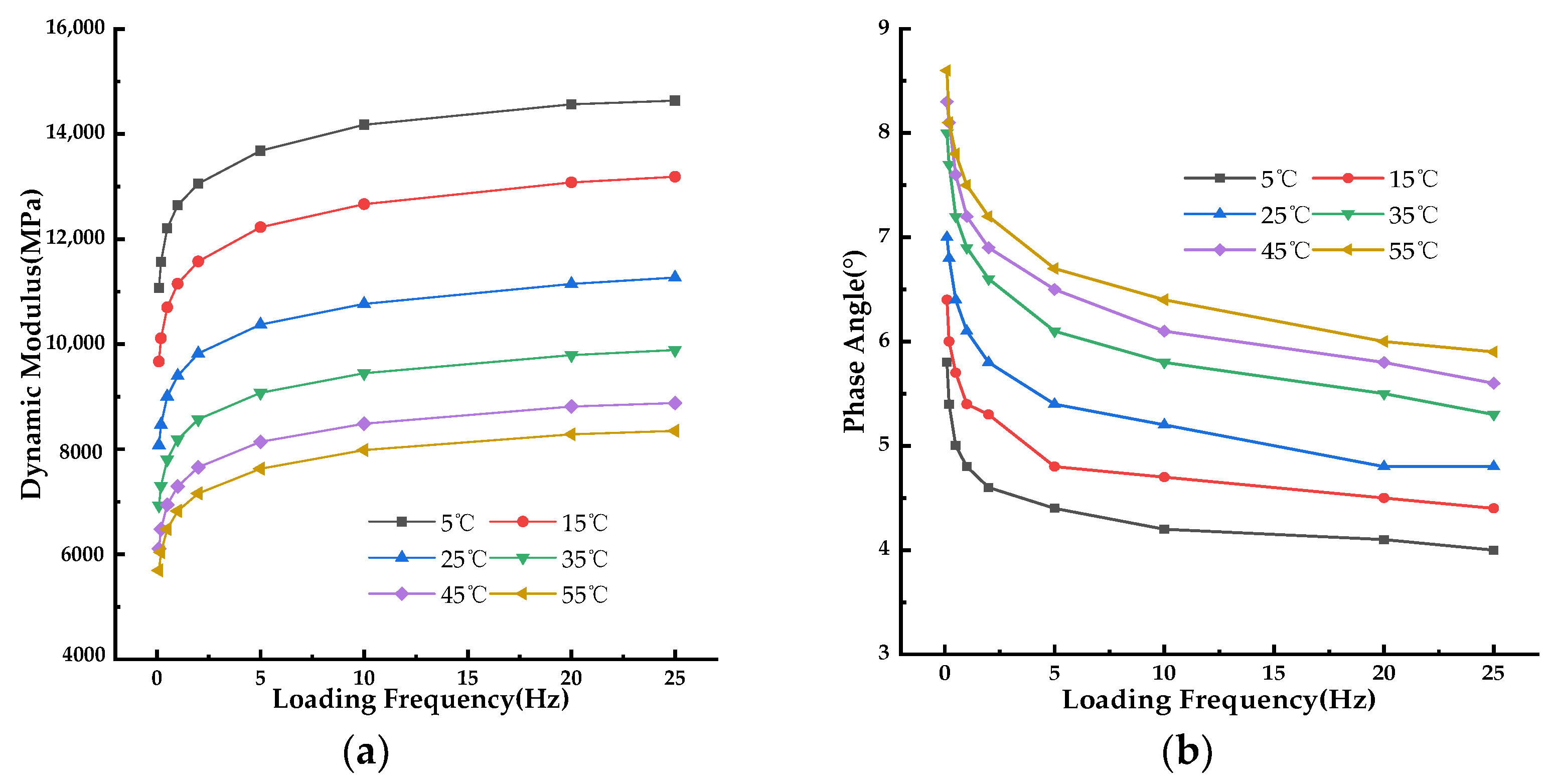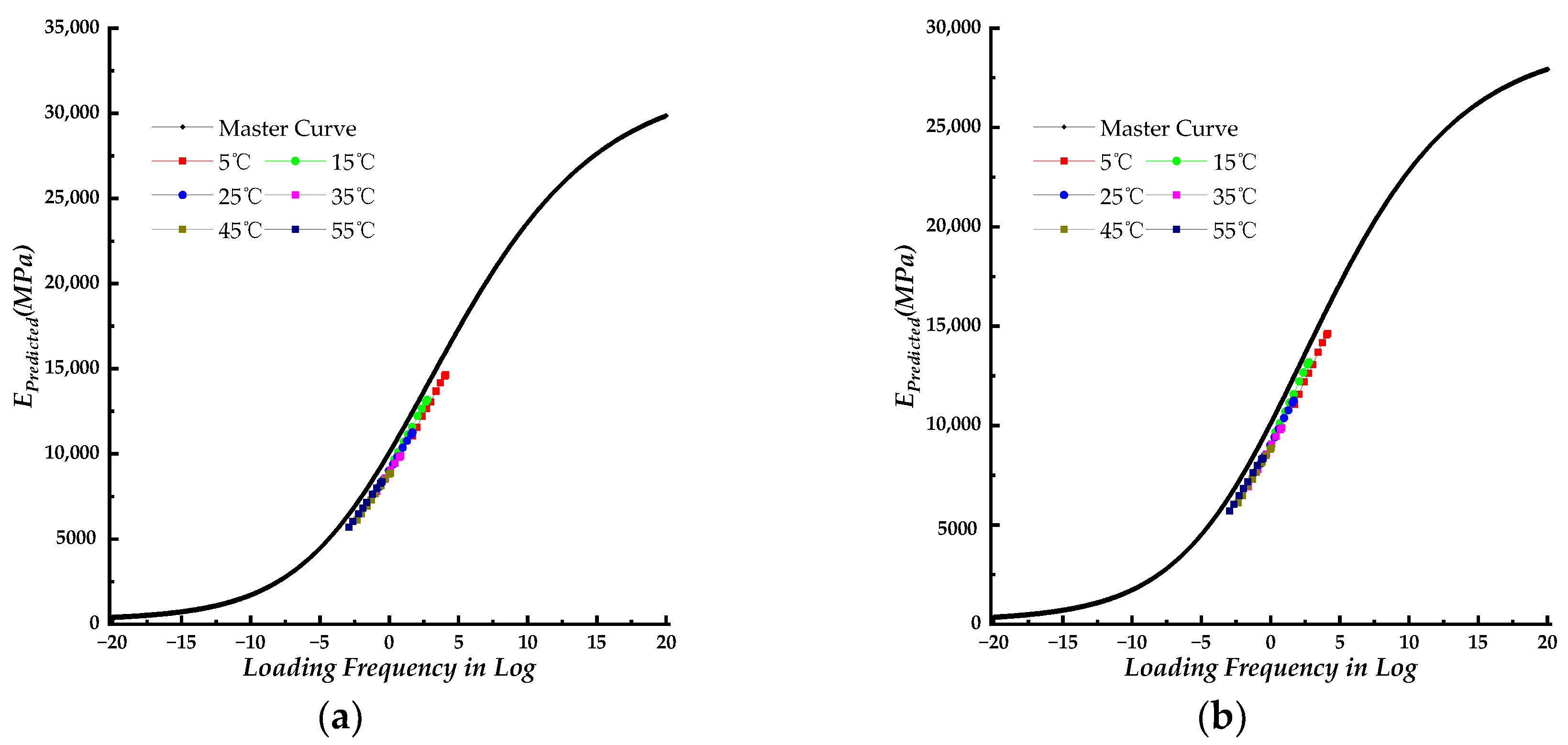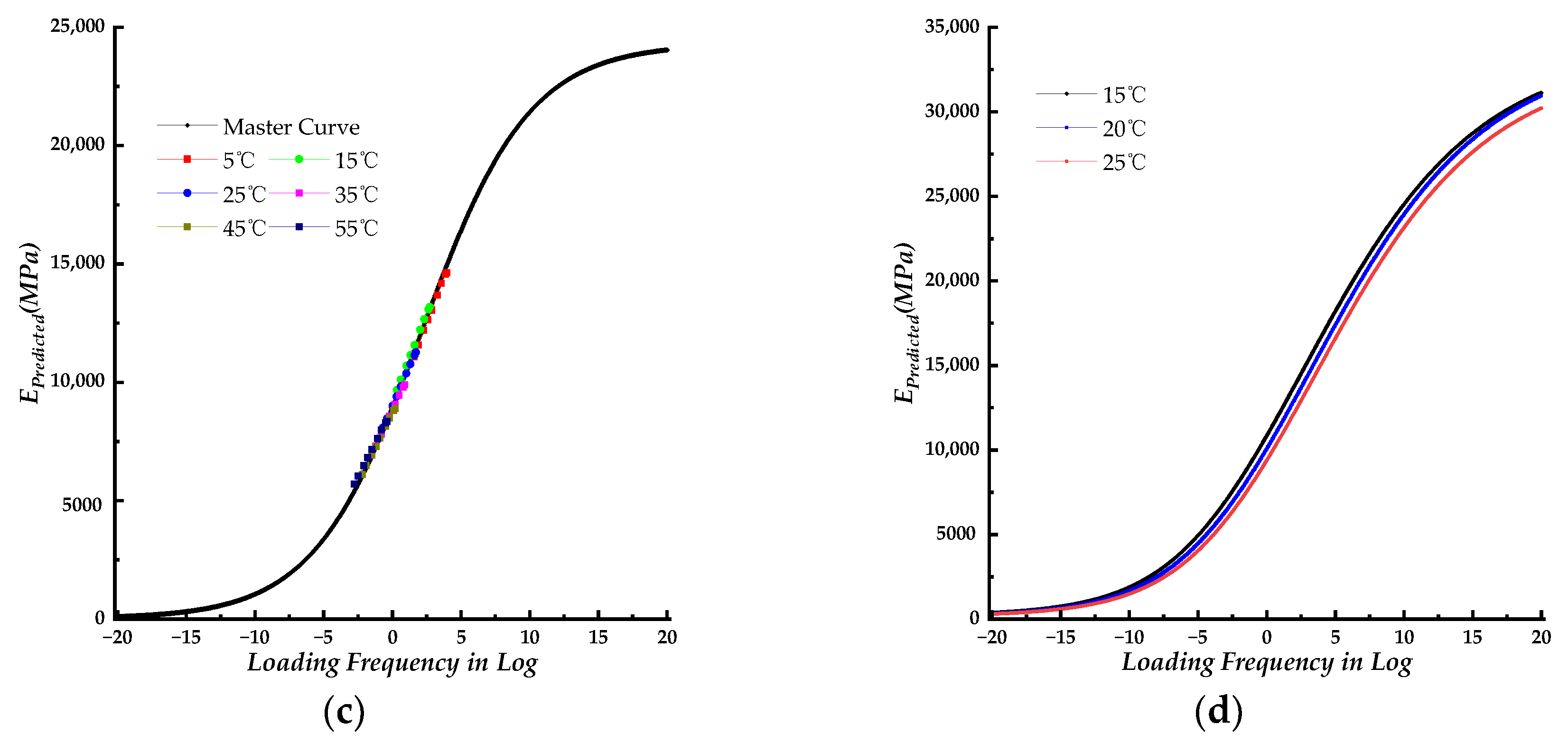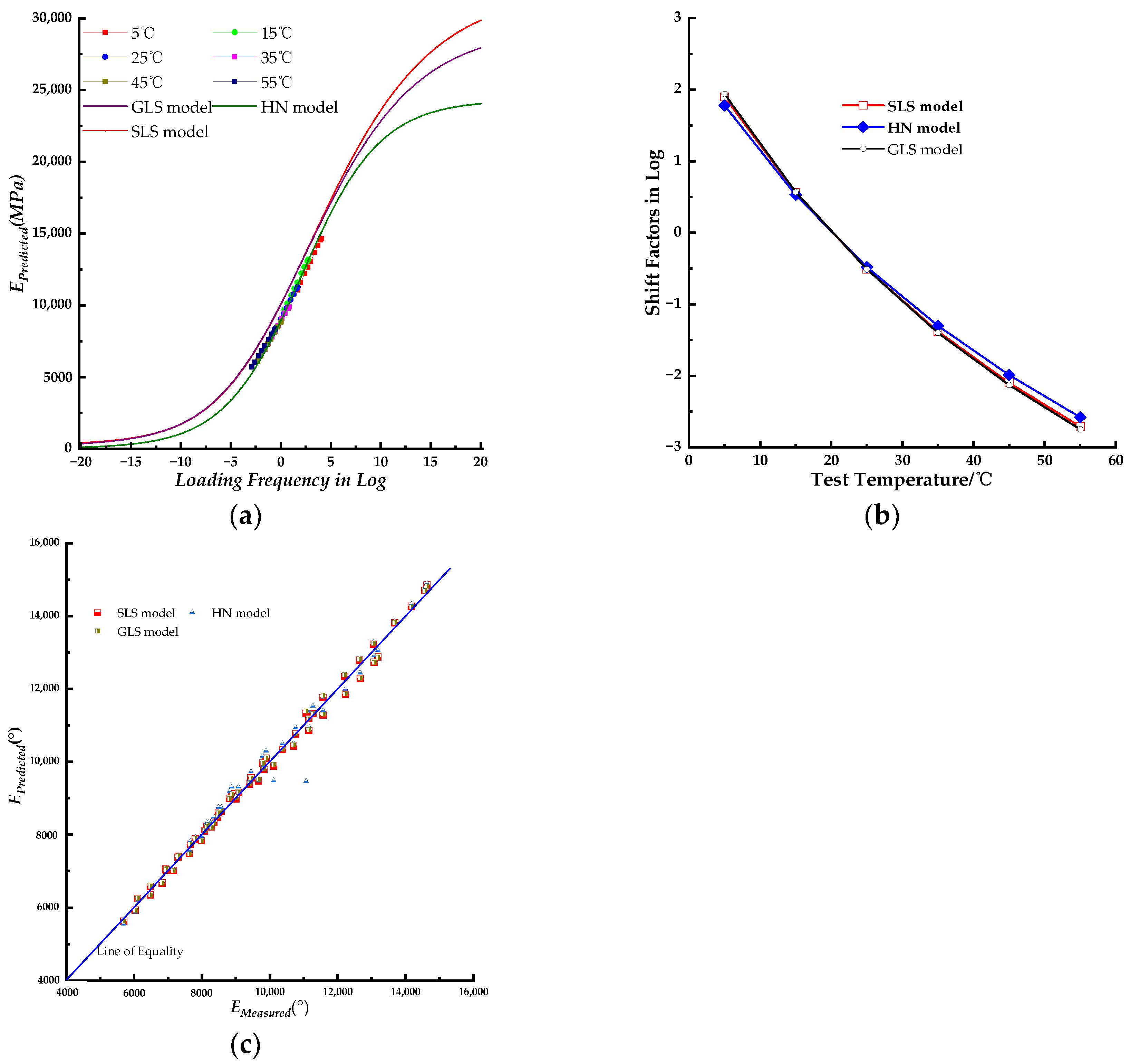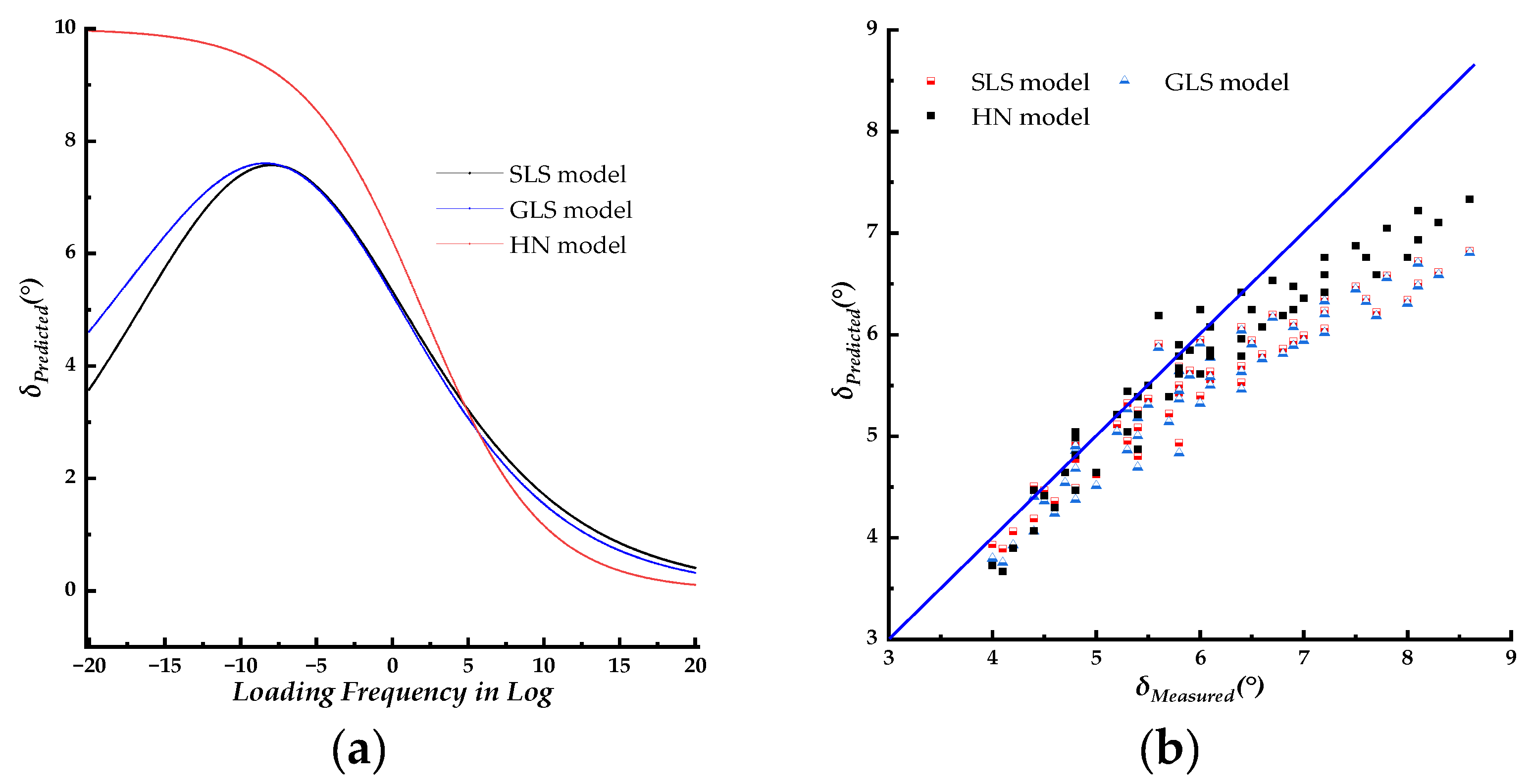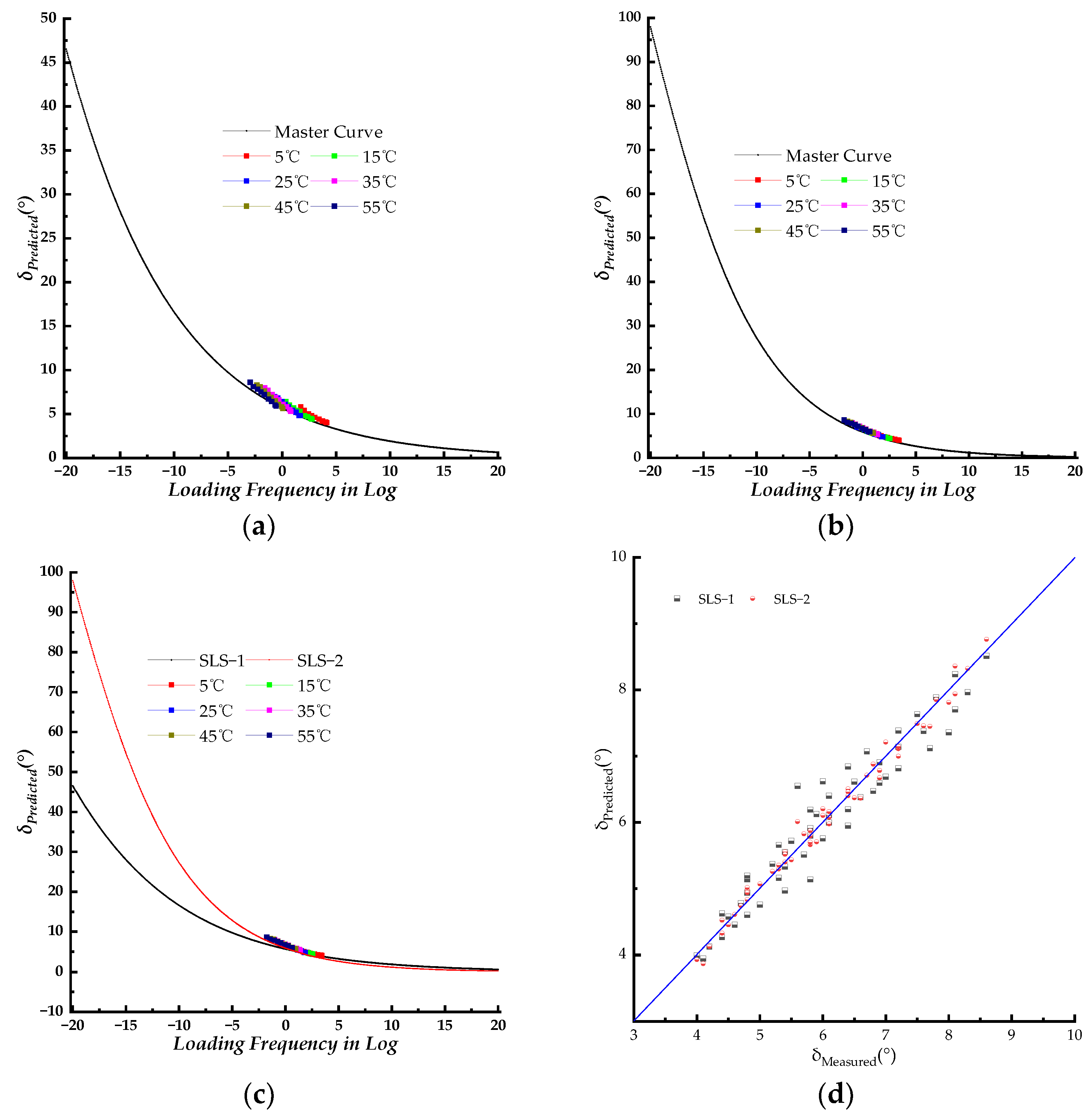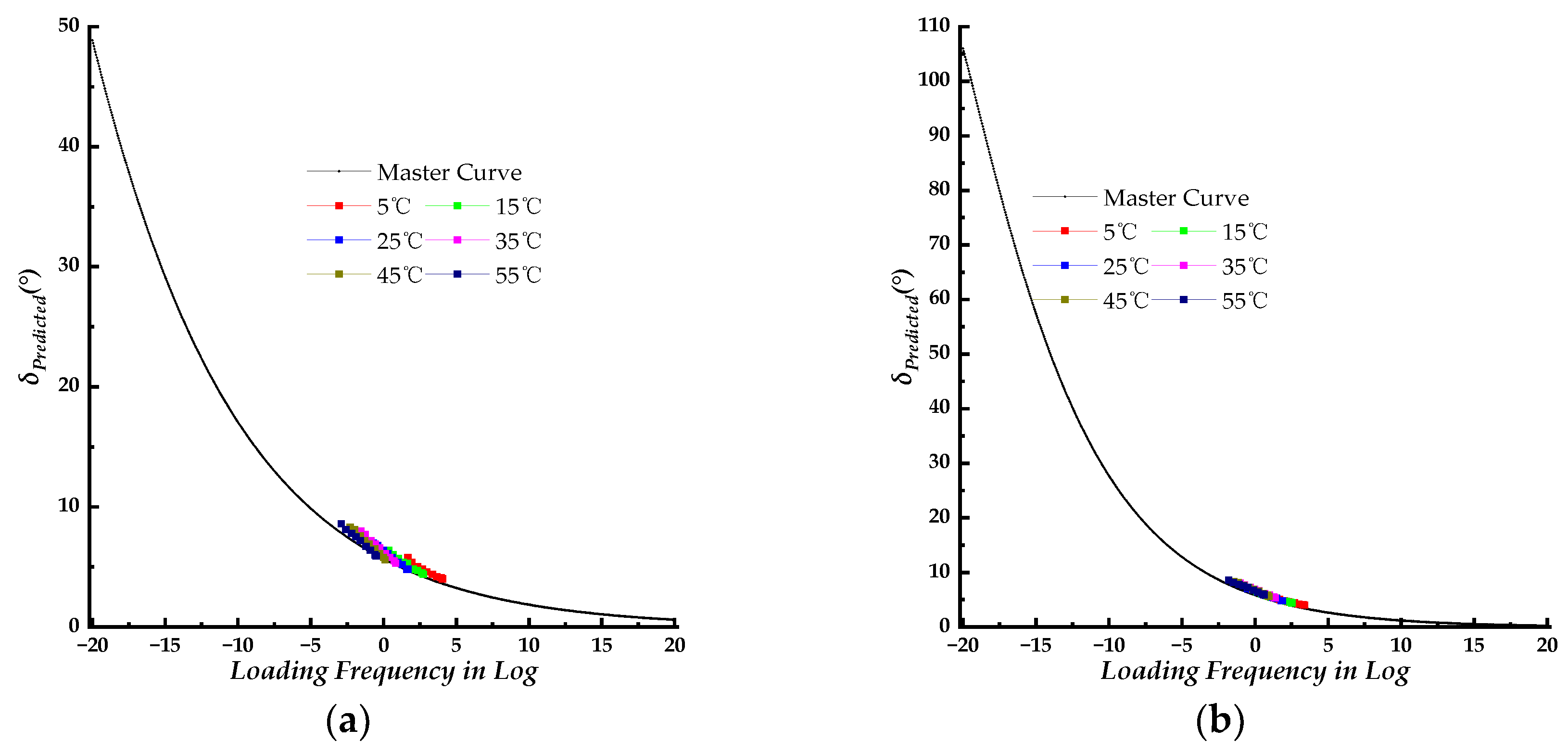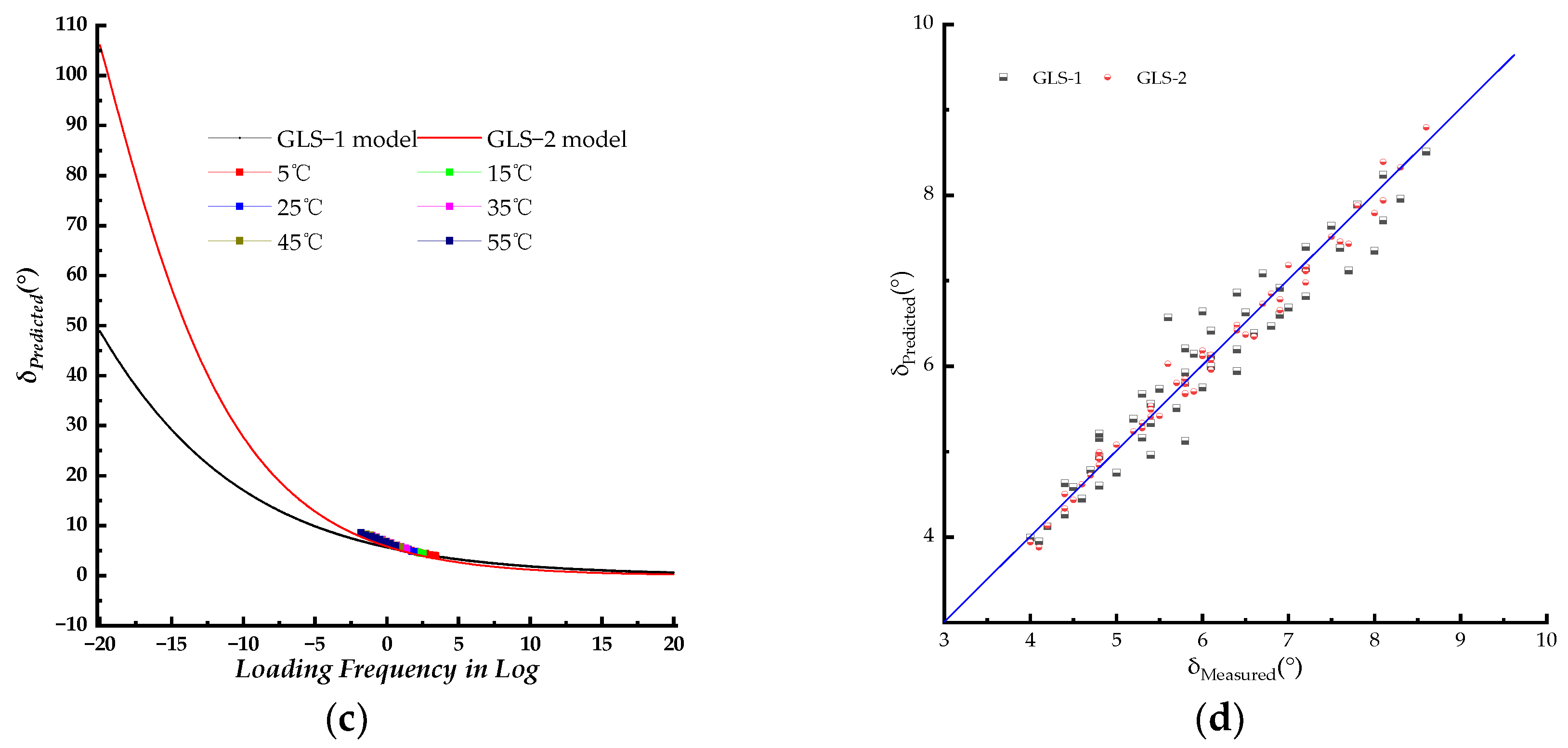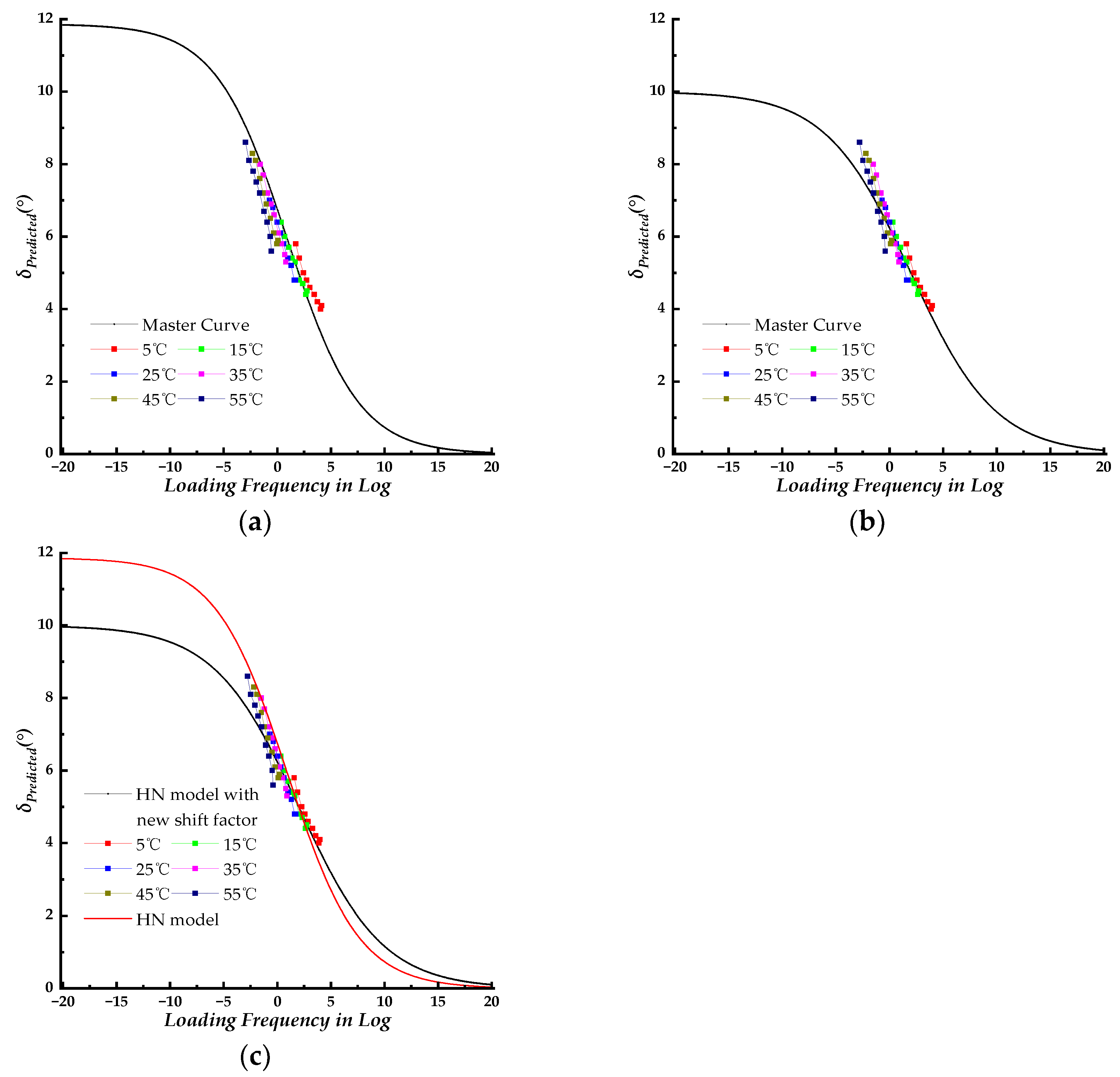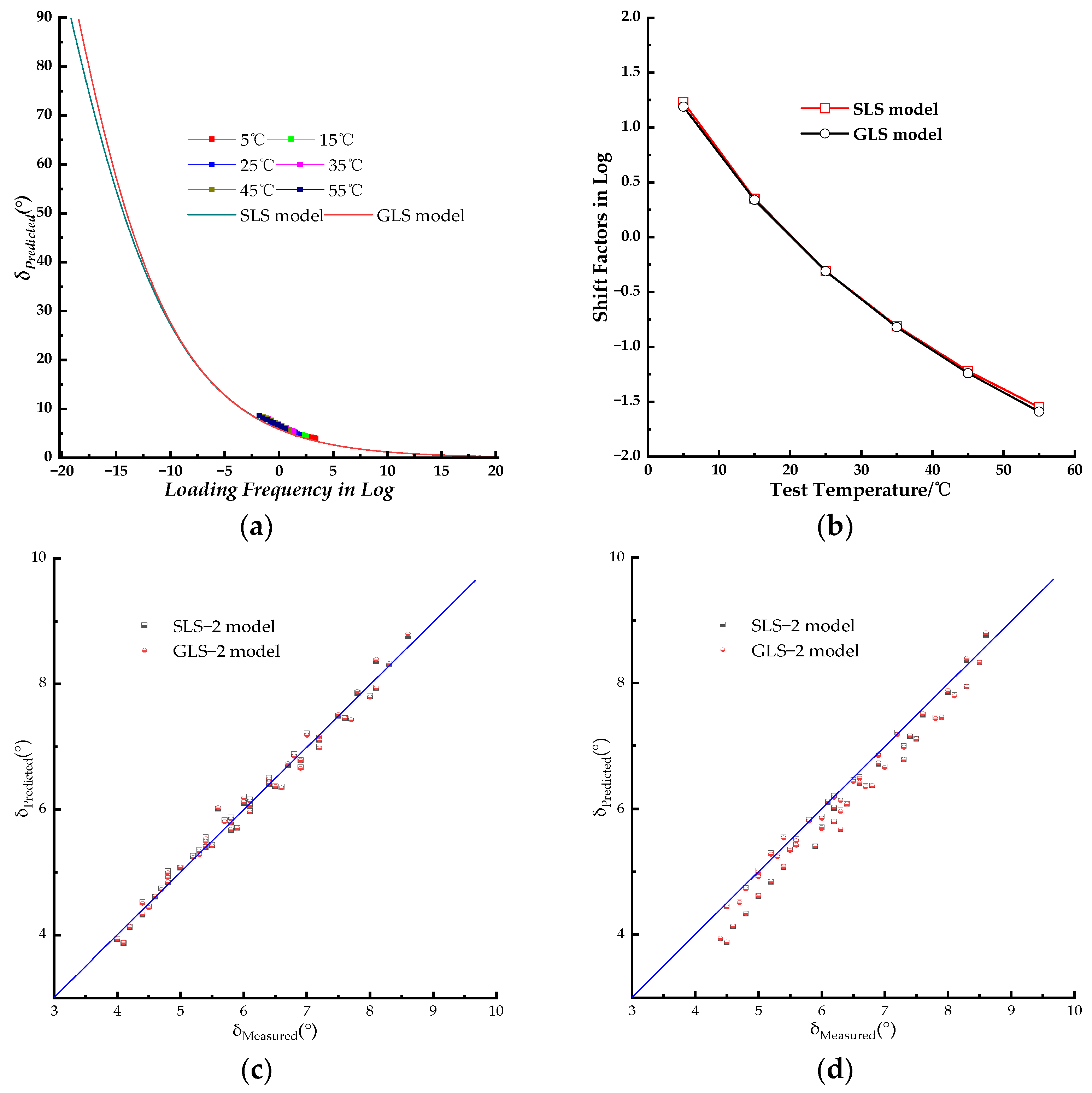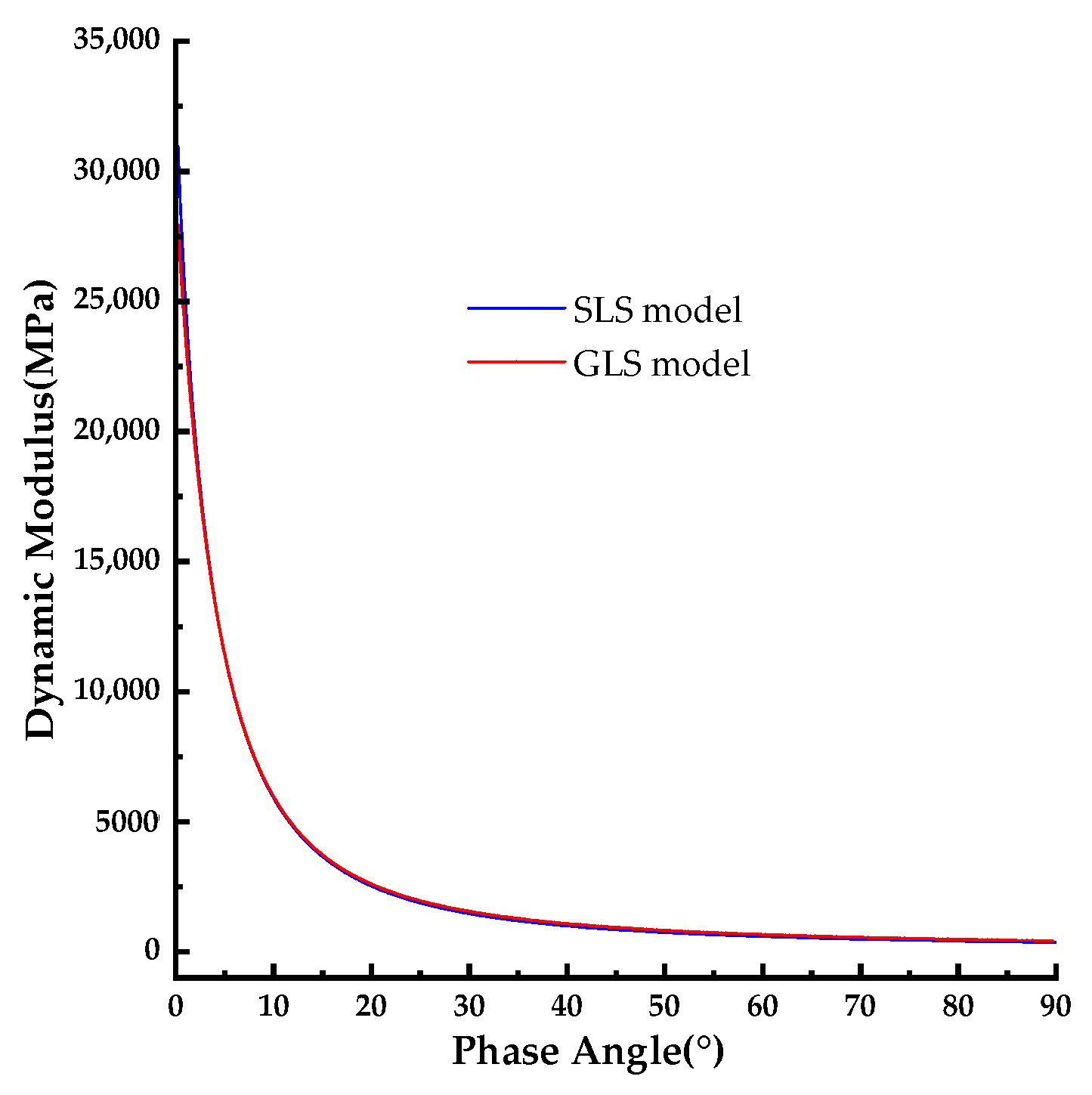4.1. Viscoelastic Properties
The mechanical property of the LVE material is dependent on test temperature, loading frequency, and loading history [
16]. The complex modulus, including dynamic modulus and phase angle, can be used to represent the mechanical property (the relationship between stress and strain) which depends on test temperature and loading frequency for LVE materials. Furthermore, the LVE material exhibits thermo−rheological simple properties within the LVE range. The dynamic modulus of HMA, a typical thermo−rheological simple material, increases with loading frequency and decreases as the test temperature increases. Conversely, the phase angle decreases with loading frequency and increases with test temperature, reaching peak values. Interpretation of the relationship between test temperature and loading frequency for LVE materials such as HMA enables the identification of identical mechanical behavior under various experimental conditions. For instance, the complex modulus measured at low loading frequency (low test temperature) is comparable to that measured at high temperature (high loading frequency).
Figure 1 presents the laboratory−measured dynamic modulus and phase angle isotherms at test temperatures ranging from 5℃ to 55℃ and loading frequencies of 25 Hz, 20 Hz, 10 Hz, 5 Hz, 2 Hz, 1 Hz, 0.5 Hz, 0.2 Hz, and 0.1 Hz to demonstrate the influence of test temperature and loading frequency.
As shown in
Figure 1a, there was a clear pattern in the dynamic modulus of the PU mixture as the loading frequencies and test temperatures varied. At constant loading frequencies, the dynamic modulus decreased as the test temperature increased. The rate of decrease gradually increased from 43% to 50.1% as the loading frequency decreased from 25 Hz to 0.1 Hz. At constant test temperatures, the dynamic modulus increased as the loading frequency increased. the rate of increase ranged from 2.36% to 32.9% as the test temperature increased from 5℃ to 55℃.
As shown in
Figure 1b, the phase angle of the PU mixture also displayed a clear trend of change with increasing loading frequencies and test temperatures. At constant loading frequency, the phase angle steadily increased with rising test temperature, and the rate of increase rose from 35.4% to 44% as the loading frequency decreased from 25 Hz to 0.1 Hz, with the highest value observed at a loading frequency of 0.5 Hz. At constant test temperature, the phase angle decreased as the loading frequency increased from 0.1 Hz to 25 Hz. Compared to HMA, the phase angle of the PU mixture exhibited a changing pattern, with a steady increase or decrease in response to increases in test temperature or loading frequency. The phase angle of HMA displays peaks at high test temperatures, and the changing trend varies depending on the test temperature. As the test temperature increased from 5℃ to 55℃, the decreasing rate ranged from 24.1% to 41.3%, indicating that it did not change gradually with each increase in temperature. The highest value was observed at a test temperature of 25℃.
Based on the foregoing discussion, the impact of test temperatures and loading frequencies on the dynamic modulus and phase angle of the PU mixture is evident. As test temperatures and loading frequencies rose, dynamic modulus and phase angle underwent gradual alterations. This result aligns with the characteristics of thermo−rheological simple materials, indicating that the PU mixture demonstrates thermo−rheological simple behavior. Nevertheless, the rates of change for dynamic modulus and phase angle exhibited varying patterns. In dynamic modulus test data, the rate of change in test temperature and loading frequency progressed steadily with increments in test temperature or loading frequency. Conversely, for phase angle, the rate of change did not progress steadily with rising test temperature or loading frequency. This suggests that the PU mixture’s dynamic modulus is less susceptible to variations in test temperature and loading frequency, and the test precision of dynamic modulus surpasses that of phase angle.
4.2. Dynamic Modulus Master Curve
If a thermo−rheological simple material like HMA is tested within the LVE range, the TTSP, which reflects the equivalence between time and temperature, can horizontally shift the test dynamic modulus isotherms along the frequency axis to a preselected reference temperature
T0 at a reduced frequency [
5,
6,
7]. The shifted test dynamic modulus isotherms at different test temperatures can construct a single continuous smooth master curve at the selected reference test temperature to fully characterize the LVE behavior of HMA [
9]. The amount of horizontal shift multiplied by the loading frequency for each isotherm is called the time−temperature shift factor α
T, which can establish an equivalence between the LVE properties measured at a frequency
f versus a temperature
T and a reduced frequency
f0 versus a reduced temperature
T0. The dynamic modulus master curve, combined with the shift factor, can predict the LVE behavior of HMA on a loading frequency and test temperature range broader than those used in experimental conditions [
7]. This is necessary because asphalt pavement experiences a wide range of temperature conditions in the field. This method is commonly applied to both polymers [
7] and asphalt mixtures [
8,
10].
The dynamic modulus isotherms, obtained at various test temperatures, are shifted to a lower frequency to establish the master curve corresponding to a reference temperature of 20℃. This process employs the SLS, GLS, and HN models, which are depicted in
Figure 2. The shifted factors are presented in
Figure 3b.
The dynamic modulus of the PU mixture decreases as the test temperature increases, as shown in
Figure 1. The tested temperature range was not wide enough to analyze the properties of the PU mixture at an extremely high temperature, which was limited by the experimental equipment. Whereas, the master curve can predict the dynamic modulus at a specific loading frequency, and the properties of the LVE material can vary with the interrelationship between loading frequency and temperature. As detailed in
Figure 2d, when the reference temperature changed from 20℃ to 15℃ (or 25℃), the master curve of the SLS model shifted only to the left (or right). Therefore, the choice of reference temperature does not impact the shape of the master curve, and the dynamic modulus master curve at a specific reference temperature can be used to predict the dynamic modulus at various test temperatures with the shifted factors. The dynamic modulus master curves obtained using the SLS, GLS, and HN models exhibited an “S” shape as a function of loading frequency (in log form, within the range of 10
−20−10
20 rad/s). As shown in
Figure 3a, all three models’ master curves exhibited similar shapes, with those of the SLS and GLS models nearly identical except at high loading frequency. The HN model’s master curve showed lower values compared to the SLS and GLS models. The GLS model exhibits the highest values.
The dynamic modulus of the thermo−rheological simple material remains at extremely low frequencies equals that at high test temperatures. As depicted in master curves in
Figure 2, the dynamic modulus values for the PU mixture didn’t approach zero at extremely high temperatures, unlike HMA. This indicates that the PU binder retains its viscous property even at extremely high temperatures, and would still be subject to external pressure combined with the aggregate skeleton. The PU mixture remains in the PU binder−dominated phase across a wider range of reduced frequency and does not shift to an aggregate−dominated phase, even at low reduced frequency or high temperature. The result indicates that the PU mixture offers improved resistance to deformation at high temperatures compared to HMA, given that the dynamic modulus of the asphalt approaches zero at extremely high temperatures, as documented in the literature [
38].
The fitting accuracy of the three models was similar, with the SLS and GLS models achieving equal accuracy as shown in
Table 2. The indexes of the goodness of fitting (SSE and
Se/
Sy) for the HN model were bigger than those of the SLS and GLS models, while the Error
2 index of the HN model was slightly lower. Based on the fitting results, all three models had relatively small values for the indexes of the goodness of fitting and were relatively close. Due to the similarity in fitting accuracy, it is challenging to solely rely on these indexes to determine the goodness of fitting. Hence, the graphical visualization analysis was introduced to compare the fitting result as shown in
Figure 2a–c and
Figure 3c. The lab−measured dynamic modulus data can be shifted to the master curve by combining the corresponding shift factors, as illustrated in
Figure 2a–c. It can be inferred from
Figure 2a,b that the shifted dynamic modulus data for the SLS and GLS models were slightly offset from the master curves, which were distributed on the right side. In
Figure 2c, the shifted dynamic modulus data of the HN model closely follow the master curve. Based on these observations, the HN model exhibits superior precision in fitting the laboratory−measured dynamic modulus of the PU mixture compared to both the SLS and GLS models. The predicted dynamic modulus values from three models were plotted against the corresponding measured dynamic modulus data in
Figure 3c. All the predicted dynamic modulus points except for two, which were generated by the HN model, were distributed along the line of equality. This suggested that the three models had a high level of precision when predicting the dynamic modulus. The linear fitting procedure was used to match the predicted and measured dynamic modulus data points, and the result is listed in
Table 5. Based on the data in
Table 5, the three models had similar fitting equations, but the
R2 values for the SLS and GLS models were higher than those of the HN model. Drawing from the comparison and analysis above, all three models demonstrated high accuracy in predicting the dynamic modulus data of the PU mixture and can be utilized to predict and assess its dynamic properties. Meanwhile, the HN model is capable of constructing a master curve that aligns with the shifted measured dynamic modulus data.
The shift factor, log(αr), indicates the difference between two temperatures. The values of log(αr) across various test temperatures, which shape the master curve, reveal the temperature−dependence nature of the LVE material. The shift factors of the SLS and GLS models were closely aligned and slightly larger than those of the HN model. This indicates that the PU mixture exhibits consistent temperature dependence that is not influenced by the model type. Hence, the selected WLF function is suitable for modeling the frequency dependence of the mechanical properties of the PU mixture.
Based on the discussion above, the shift factors used to shift the dynamic modulus isotherms tested at various temperatures for the PU mixture can be determined by the WLF function. This suggests that the TTSP method is suitable for shifting the measured dynamic modulus data for the PU mixture. The SLS, GLS, and HN models can be used to construct a single master curve for predicting the dynamic modulus data of the PU mixture. The shapes of these master curves across different models remain similar, indicating that they were not significantly affected by the selected reference temperatures. Therefore, the dynamic modulus of the PU mixture reflects its frequency and temperature dependence, which is typical for viscoelastic materials. This indicates that the PU mixture exhibits certain viscoelastic properties.
4.3. Prediction of the Phase Angle Master Curve from Corresponding Dynamic Modulus Master Curve
This section evaluates the utilization of a fundamental relationship method to predict phase angle based on the slope of the log−log of the dynamic modulus master curve, also known as the K−K relations. The Equations (5)–(7) were utilized to construct the phase angle master curves for the SLS, GLS, and HN models, incorporating the WLF shift factors. The equations were derived from the corresponding dynamic modulus based on the K−K relations. Therefore, it is expected that the Equations (5)–(7) should utilize the fitted parameters obtained from the dynamic modulus master curve fitting process. The corresponding phase angle master curves are presented in
Figure 4a. The predicted phase angle data were plotted versus the laboratory−measured phase angle data in
Figure 4b.
According to
Figure 4a, the predicted phase angle master curve of all three models showed small values, with peak values ranging from 5−10 °. The maximum laboratory−measured phase angle was approximately 9 ° at a test temperature of 55℃. As illustrated in
Figure 1b, the phase angle increases as the test temperature rises. Therefore, it can be inferred that the phase angle values of the PU mixture will exceed 9 ° when the test temperature exceeds 55℃. This indicates that the phase angle master curves constructed using the fitting parameters of the dynamic modulus master curve do not apply to the PU mixture. The predicted phase angle values from different models were distributed along the line of equality but with large discrepancies. Most of the predicted phase angle data were smaller than the measured phase angle data. This further confirms that the phase angle master curve with the fitted parameters of the dynamic modulus does not apply to the PU mixture. The phase angle master curve models should be fitted with new parameters to accurately characterize the LVE properties of the PU mixture.
In theory, the shift factors used to shift the phase angle and dynamic modulus data should be identical. The phase angle master curves constructed using the SLS, GLS, and HN models combined with the WLF shift factors of the corresponding dynamic modulus are displayed in
Figure 5a,
Figure 6a and
Figure 7a, respectively. A separate phase angle master curve fitting procedure was conducted based on the Equations (5)–(7) with newly fitted WLF shift factors. The results are presented in
Figure 5b,
Figure 6b and
Figure 7b, respectively. The experimental phase angle data were shifted to the master curve at the reference temperature of 20℃ for a visual comparison between experimental and predicted values.
For the SLS model, the SLS−1 model represents the phase angle master curve constructed using the same WLF shift factors as the dynamic modulus, while the SLS−2 model represents the phase angle master curve constructed using newly fitted WLF shift factors. The master curves of the SLS−1 model and SLS−2 model displayed similar shapes, as shown in
Figure 5c. As the loading frequency increased, the phase angle gradually decreased. There was no peak on the phase angle master curves, indicating that no phase transition occurred during the change in loading frequency (or test temperature). This indicates that the PU mixture is dominated by both the PU binder and aggregate, which differs from HMA [
39,
40]. The SLS−2 model was higher than the SLS−1 model when the loading frequency was less than 10 rad/s. However, both master curves merged when the loading frequency exceeded 10 rad/s, as shown in
Figure 5c. The measured phase angle data were shifted to the master curves using corresponding WLF shift factors. The shifted phase angle data points were distributed along the master curve. When compared to the SLS−2 model, the shifted phase angle data points of the SLS−1 model exhibited slighter dispersion. This was further supported by comparing measured and predicted phase angle data in
Figure 5d. The data point of the SLS−1 model exhibited a larger dispersion compared to that of the SLS−2 model. The linear fitting process was carried out for the predicted and measured phase angle data points shown in
Figure 5d, and the fitting results are presented in
Table 6.
Based on the fitting accuracy presented in
Table 3, the SLS−2 model produced higher predicting accuracy with higher
R2 values and lower values of SSE, Error
2, and
Se/
Sy. As shown in
Table 6, the SLS−2 model can predict more accurate phase angle data compared to the SLS−1 model. This is because the linear equation fit for the SLS−2 model resulted in a smaller intercept, a larger slope of the line, and a higher
R2 value. Therefore, the SLS−2 model is capable of fitting and predicting the measured phase angle with higher precision compared to the SLS−1 model.
For the GLS model, the GLS−1 model and GLS−2 model represent the phase angle master curve constructed using the same WLF shift factors of corresponding dynamic modulus and newly fitted WLF shift factors, respectively. The master curve of the GLS−1 model and GLS−2 model exhibited similar shapes, with the phase angle decreasing steadily as the loading frequency increased. There were also no peaks observed on the master curves of the GLS−1 model and GLS−2 model, indicating that the PU binder did not undergo any phase transitioning within the loading frequency range. As depicted in
Figure 6c, the master curve of the GLS−2 model was higher than that of the GLS−1 model. When the loading frequency exceeded 10 rad/s, the master curves of GLS−1 and GLS−2 merged. The measured phase angle data points were shifted onto the master curve using different WLF shift factors, and the shifted phase angle data points were distributed along the master curves. Additionally, as shown in
Figure 6a,b, the shifted phase angle points for the GLS−2 model exhibited small dispersion compared to those of the GLS−1 model, which was also evident from
Figure 6d. In
Figure 6d, both the measured and predicted phase angle data points for the GLS−1 model and GLS−2 model were plotted, with the data points for GLS−1 exhibiting greater dispersion than those of GLS−2. The linear relationship was fitted between the experimental and predicted values obtained from different predictive models. The fitted equations were then used to compare on a unity plot (x=y) in
Figure 6d. The fitting results are listed in
Table 7.
As shown in the fitting results of the GLS model in
Table 4, the GLS−2 model resulted in better fitting results with a higher
R2 value, and lower values of SSE, Error
2, and
Se/
Sy compared to the GLS−1 model. As detailed in
Table 7, the linear fitting results of the GLS−2 model were superior to that of the GLS−1 model. This was because the intercept of the fitting line of the GLS−2 model was smaller, and both the slope of fitting and
R2 value were larger than that of the GLS−1 model. This suggests that the same shift factors of the dynamic modulus with the GLS−1 model can magnify the discrepancy between predicted and measured phase angle values. Consequently, the GLS−2 model offers a more precise prediction of phase angle data compared to the GLS−1 model.
For the HN model, the HN−1 model and HN−2 model represent the phase angle master curve constructed using the same WLF shift factors of the corresponding dynamic modulus and newly fitted WLF shift factors, respectively. The phase angle maser curves displayed in
Figure 7a,b had similar shapes but were distinct from those of the SLS and GLS models. The range of the master curves constructed using the HN−1 model and HN−2 model was 0 to 12 ° and 10 °, respectively. The phase angle ranges were significantly smaller than that of LVE materials (0−90 °), indicating that the HN model is unsuitable for fitting and analyzing phase angle data of the PU mixture.
Based on the analysis above, it was found that the SLS−2 and GLS−2 models exhibited higher fitting precision compared to their respective SLS−1 and GLS−1 models. This indicates that the models using newly fitted WLF shift factors for phase angle master curves can better predict measured phase angle data across various test temperatures. Therefore, the SLS−2 and GLS−2 models were selected for further comparison. The phase angle for LVE material is from 0 to 90 °. The corresponding loading frequency for the SLS−2 model is from 10
−19.15 to 10
20 rad/s, while that for the GLS−2 model is from 10
−18.45 to 10
20 rad/s. The SLS−2 and GLS−2 model master curves were plotted together in
Figure 7a. The SLS−2 and GLS−2 model master curves merged when the loading frequency exceeded 10
−5 rad/s. At the same loading frequency, the GLS−2 model master curve was slightly higher than the SLS−2 model curve, with the difference increasing as the loading frequency decreased. As shown in
Figure 8a, the predicted phase angle master curves are in good agreement with the laboratory’s experimental results. The fitting accuracy of the SLS−2 and GLS−2 models, as indicated in
Table 3 and
Table 4, suggests that both models have similar fitting accuracy. As shown in
Figure 8c, the measured phase angle data points were plotted against the predicted phase angle values by SLS−2 and GLS−2 models.
Table 6 and
Table 7 present the linear fitting results, which show that the SLS−2 and GLS−2 models were similar, and exhibit near dispersion around the line of equality. Considering the variability of phase angle measurements at different temperatures, the SLS and GLS models with newly fitted WLF shift factors can predict the phase angle by using Equations (5) and (6) with acceptable high predicting accuracy.
The phase angle data from the control group were plotted against the predicted phase angle at the same loading frequency and test temperature in
Figure 8d, the linear fitting results between predicted and measured phase angle data were listed in
Table 8. Based on the linear fitting results, the SLS and GLS model could predict the phase angle data within the test temperature and loading frequency, for the
R2 value was high, and the slope of the fitting linear was close to 1, which indicated that the measured phase angle data were slightly higher than the predicted data. These comparing results indicated that the phase angle data could be predicted by the phase angle master curve which was constructed by K−K relation with relatively high precision within the test temperature and loading frequency.
The prediction of phase angle from dynamic modulus relies on the assumption of linear viscoelastic behavior in the small strain region, and materials can be considered thermo−rheological simple. Additionally, the time−temperature supposition must be valid [
16]. Based on the analysis above, if the dynamic modulus SLS and GLS functions for the master curves are known, the corresponding phase angle master curve SLS and GLS functions can be derived using the interconversion method in the form of the Hilbert integral transforms. Subsequently, the corresponding SLS and GLS models for phase angle, combined with the WLF function, can be utilized to fit the measured phase angle data with acceptable prediction precision. However, the parameters obtained from fitting the dynamic modulus master curve cannot be directly applied to constructing the phase angle master curve. Therefore, it is not possible to predict the phase angle of the PU mixture from its corresponding dynamic modulus data. The K−K relation did not completely apply to the PU mixture; currently, the phase angle can only be determined through a complex modulus test.
4.4. Core−Core and Black Space Diagrams
Several diagrams are commonly used to present complex modulus test results in the complex plane. For example, the Core−Core plot [
41] plots the loss modulus against the storage modulus, or the Black Space plot [
7] plots the phase angle versus the dynamic modulus. It has been shown that for a thermo−rheological simple asphalt mixture if the complex modulus is measured at various temperatures and frequencies, all associated data points fall on a single curve in these diagrams [
42]. In this study, the Core−Core and black space plots were used to analyze the complex plane behavior of the PU mixture. In this section, the fitting results of SLS−2 and GLS−2 models were used in the Core−Core and black space analysis.
The Core−Core plots of the SLS and GLS models, shown in
Figure 9a,b, displayed a single curve with one peak within a phase angle range of 0−90 °. This indicated that the PU mixture exhibits thermo−rheological simple properties to some extent. For the Core−Core plots of the SLS and GLS models shown in
Figure 9a,b, the phase angle ranged from 0 to 90 °, indicating that the PU mixture was within the LVE range. When the storage modulus approached 0, the loss modulus was greater than 0, indicating that the PU mixture maintains its viscosity property at high temperatures. Therefore, the PU binder maintains its viscosity at extremely high temperatures and can combined with the aggregate skeleton to resist high−temperature deformation under stress. As the temperature decreases, the phase angle decreases as shown in
Figure 9a. Both the loss modulus and storage modulus increase, and the loss storage reaches its peaks decreasing with further temperature increases. The peak value of loss storage is significantly lower than that of the storage modulus, indicating that the PU mixture exhibits viscosity and elastic properties that predominantly determine its dynamic behavior. The PU mixture exhibits elastic properties and only displays certain viscosity properties at extremely high temperatures. However, the PU mixture maintains its viscosity even at extremely low temperatures. The Core−Core plots of the SLS and GLS models display similar shapes, but there are differences in loss modulus and storage modulus values at extremely high and low temperatures. However, the peaks of the plots have nearly the same position and values. This shows both the SLS and GLS models can fit the loss modulus and storage modulus of the PU mixture. Furthermore, the loss modulus and storage modulus calculated from the dynamic modulus and phase angle can be employed to determine the LVE properties of the PU mixture at a given test temperature and loading frequency with high precision. A good indication of thermo−rheological simplicity is through the Core−Core plot, which shows the locus of the complex modulus in a complex plane as described by [
43]. If all data are close to one curve, it satisfies the requirements for thermo−rheological simplicity. This result confirms that the K−K relation can be used to analyze the loss modulus and storage modulus of the PU mixture.
The black space diagram can evaluate the asphalt mixture stiffness and relaxation capability through a plot of dynamic modulus as a function of phase angle. The black space diagram and Core−Core diagrams were used to assess the quality of rheological data and confirm the thermo−rheological simplicity of the asphalt mixture [
44,
45,
46]. In this section, both measured and predicted phase angle data were employed in the black space diagram to assess the relative location of the points.
As shown in
Figure 10a,b, the black space diagrams for both the SLS and GLS models draw a single continuous curve, indicating that overlapping isotherms at various temperatures. This suggests that the PU mixture possesses the thermo−rheological simple property. In complex modulus tests, each phase angle data corresponds to a single dynamic modulus value for the LVE material. The smoothness of the black space diagram indicates that the mechanical behavior, evaluated through dynamic modulus and phase angle, can be determined across a range of temperatures and loading frequencies. This is consistent with time−temperature equivalence. As shown in
Figure 10a,b, the black space diagrams for both SLS and GLS models decreased with an increasing phase angle, and they do not exhibit an inflection point during this change, unlike the black space diagram of HMA. This suggests that, in comparison to HMA, the PU mixture possesses reduced rheological properties and is less impacted by the temperature, further supporting its thermo−rheological simple property. The black space diagrams for the SLS and GLS models were plotted together in
Figure 10c, the black space diagrams demonstrate nearly identical shapes and values for both SLS and GLS models. This suggests that the model type does not significantly impact the rheological property of the PU mixture.
